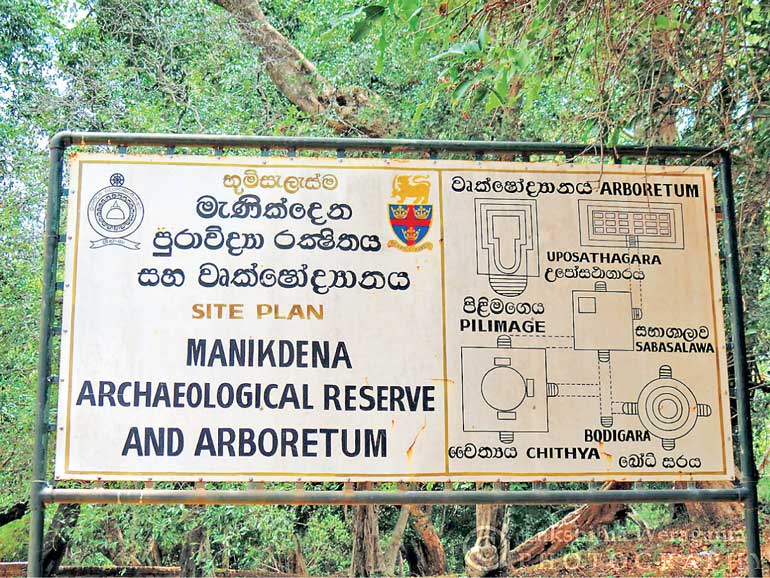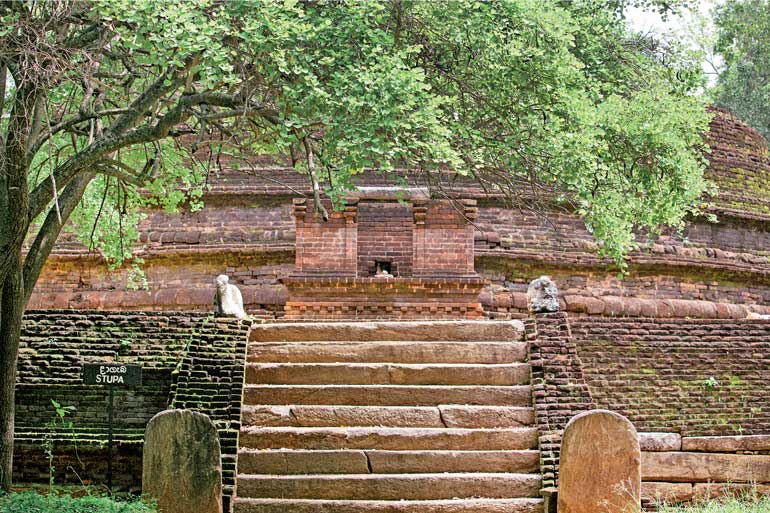Tuesday Dec 23, 2025
Tuesday Dec 23, 2025
Saturday, 16 December 2017 00:15 - - {{hitsCtrl.values.hits}}


By Aysha Maryam Cassim
An arboretum is a garden where plants, trees and herbs are cultivated for conservation and scientific study. Simply put, it’s a museum, devoted to trees. Menikdena Arboretum is not just a botanical library. As you meander along the network of forest canopies, you will come across ruins of a bygone era here and there.
Menikdena Arboretum in Matale District spans an area of 35 acres of forest land which is rich in biodiversity. Before it was declared as an archaeological nature reserve, the site was strewn with weeds and ridden with debris and termites. The sacred grove was left to be neglected and abandoned for many years, making it a treasure trove for vandals and hunters.
Menikdena Project
A few decades ago, Menikdena forest reserve was given a new life with a breath of fresh air thanks to the dedicated efforts by Trinity College Kandy. Along with the approval and support provided by former Director General of Archaeology, Dr. Siran. U. Deraniyagala, Trinity College undertook this pioneering project in collaboration with the Sri Lanka Archaeological Department.
Menikdena Project is considered as a path-breaking venture in the history of Sri Lanka, where a school has taken an initiative to establish an arboretum cum archaeological reserve in order to develop a site of multidisciplinary interests.
How to get there
Dambulla is a well-known touristic town, located in the dry zone of Sri Lanka. The evergreen forest groves, rocky boulders, villages surrounded by Chena lands and arboretums represent the lush vegetation of the area.
Menikdena Archaeological reserve lies on the main Dambulla-Kandy Road just a few kilometres away from the Dambulla town. It’s only an hour away from Matale. Drive along the A9 Kandy-Jaffna Road and take a turn to the left from Pannampitiya junction to reach your destination. From Colombo, it will take you around four hours via Kurunegala-Dambulla road passing Galewela and Matale. En route, visit the Nalanda Gedige shrine and Matale Alu Viharaya before you head towards the Arboretum.
The reserve can be found on a picturesque landscape where the beautiful Menikdena tank meets the Menikdena Hill range reaching an 875m height. A guide will escort you around the forest reserve, explaining the architectural details and the historical significance of its structures. Three dogs accompanied me along the network of nature’s trails, making it a pleasurable excursion for me.
The history
The origins of Menikdena Monastery date back to the time of King Kitsiri Mevan (555-573 AD). Historical evidence indicates that Menikdena was temporarily used as a military base by King Vijayabahu I (1110-1111 AD) during his campaign against the Cholas. The monastic site also served the same purpose during the campaign of King Parakramabahu I, against King Gajabahu II (1132-1153 AD).
“On the death of Vikrama Bahu, after a rule of twenty-one years, and the accession of his son, Gaja Bahu II (A.D 1131-1153), Sri Vallabha and Kitti Siri Megha attacked the ‘King’s Country,’ but failed in their enterprise. Parakramabahu had now grown up and went to the country of his birth, where he lived at his uncle’s court. His ambitious spirit made him leave the court. He went to Batalagoda, where the general in command was killed, and then through Hiriyala, to Buddhagama (Menikdena Nuwara in Matale District), he intrigued with Gaja Bahu’s general in Kalavewa.” – Short History of Ceylon by H.W Codrington.
Visiting the ‘Panchavasa’ of the Monastic Complex
The ruins and remnants of Menikdena reveal the site of an old Monastic Complex which consists of five structures known as “Panchawasa” that can be found in a typical monastic complex. They are namely:
As you enter the premises, there is a granite pillar inscription right before you make your way along the steps, flanked by Muragal (Guard Stones). The Moonstone famously known as Sandakadapahana is devoid of any carvings.
Before the excavation, most of the stone pillars in the image and chapter house were buried underneath. The dagoba was completely hidden by the scrub jungle. During the restoration process carried out by the Department of Archaeology, engineering bricks were used in the image houses, where the pieces of stone had been missing.
Menikdena was also known as Budhdhagaama. An inscription found on a slab which was discovered on the premises mentions that a temple called Budugam Vehera existed during that period. The layout and the structures located at the Arboretum resemble a Panchavasa which was used as a monastic establishment centuries ago, by Monks who would retreat into to forests to meditate and seek solace in pursuit of a spiritual quest with a great appreciation for nature.
